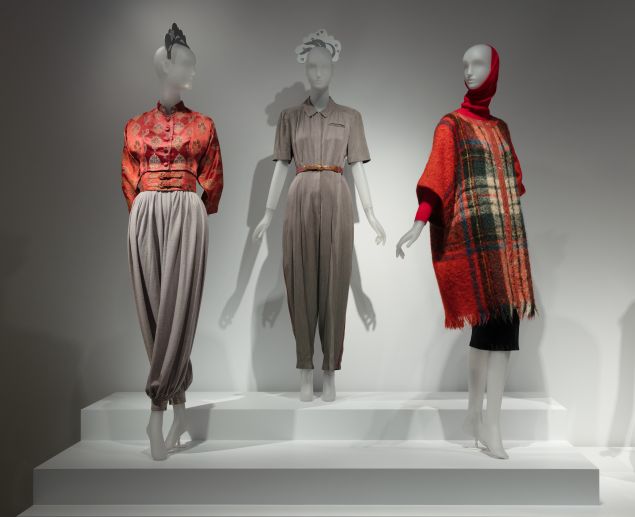When it comes to fashion, we tend to celebrate male designers. Whether it’s Claudia Schiffer crediting Karl Lagerfeld for her success, Thierry Mugler’s PR-fueled friendship with Kim Kardashian or Naomi Campbell’s long-standing relationship with Azzedine Alaïa, men have always dressed women.

We’re no strangers to this, so it’s incredibly refreshing to see many of the overlooked women designers of our time at The Costume Institute’s fall 2023 exhibition, “Women Dressing Women” at the Metropolitan Museum of Art. It celebrates the creativity and artistic legacy of women—and boy, is that overdue.
Women designers like Rei Kawakubo for Comme des Garçons, Miuccia Prada, Jeanne Lanvin, and Vivienne Westwood are celebrated alongside women-led fashion houses like No Sesso and Collina Strada. The exhibition runs from December 7 through March 3, 2024, highlighting eighty pieces from the 20th Century onward that, according to Met director Max Hollein, will spotlight “historically underappreciated voices” and elevate women who “continue to be the lifeblood of the global fashion industry we see today.”
Upon descending a white staircase, the first three works in the show set the tone for the exhibition: three pieces of black eveningwear from three European designers. It showcases pieces from House of Vionnet, which was run by French designer Madeleine Vionnet, a two-piece from Italian designer Elsa Schiaparelli and an evening dress by Gabrielle Chanel from the autumn/winter 1938-39 collection released when the world was on the brink of war.


The exhibition is divided into four sections: Anonymity, Visibility, Agency and Absence/Omission, but because of the way the exhibition is curated, they all blend together. What really separates them is the written paragraphs on the white panels below each mannequin (with the odd QR code to a video). It isn’t the most interactive or exciting exhibit at the Costume Institute—especially considering their previous use of savvy video and clever architectural design (look back on the Karl Lagerfeld exhibition, for example). This one is purely mannequin and feels slightly mute, which is quite the underachievement considering women have come so far in fashion.
There are just a handful of political fashion pieces in the exhibition, but there could be more because they do a lot to capture the bold voice of women designers. Look at Vivienne Tam’s Mao suit from her spring/summer 1995 collection, depicting a black and white pattern of Chinese leader Mao Zedong, who ran the country from 1966 to 1976, which, according to the museum, symbolizes the positive and negative effects of Mao’s influence on China.


There’s also a 1985 t-shirt from British designer Katharine Hamnett, a pioneer in sustainable fashion, who uses her line to tackle climate change, address plastic pollution, advocate for nuclear disarmament and more. This red silkscreen t-shirt was inspired by a protest of US nuclear weapons on British common land, led by the Greenham Common Women’s Peace Camp in Berkshire, England.
One piece makes you think about all the women designers who’ve honed their craft and then given all their ideas to male designers, receiving less credit than a boldface name that’s on the back tag of a dress or none at all. Look at the silver, sequin piece called the “Ensemble” dress designed by Sarah Burton for Alexander McQueen’s spring/summer 2012 collection (McQueen himself died in 2010). The handwork on this piece is detailed and magical, resulting in something like a metallic angel that carries McQueen’s own poetic, dramatic spirit. Burton took over the role of lead designer after McQueen’s passing, stepping into a demanding role she held for more than thirteen years and echoing McQueen’s design voice while carrying her own in his shadows. It’s daunting thinking about what she went through.


According to associate curator Mellissa Huber, the exhibition offers insight into “the critical histories of innovative women designers all of whom played pivotal roles in the conception of fashion, as we know it today” and “represents a rich timeline of western fashion history” and the “diversity of women’s important contributions to the field.”
One recurring theme of this small-scale, basement exhibition—nothing compared to the sprawling Lagerfeld survey—is the emphasis placed on the dress. Where are the pantsuits, the jeans, the shoes and the accessories? The whole thing is hyper-feminine, but women designers have long broken through that stereotype, and that’s not fully captured here.
Some of the smartest designs here are by underrated, overlooked designers like Barbara Hulanicki, who ran the British brand Biba from 1963 to 1975. There’s a leopard print pantsuit here designed by Hulanicki, which is gorgeous, not to mention timeless, and a wild stamp from the flower power era. Her brand was like the bohemian H&M of the swinging 1960s, affordable for a younger generation. Biba had its own seven-story department store in London, which not only sold clothing, but cosmetics and furniture. The outfit on display was owned by artist Luciana Martinez de la Rosa.
Hulancki, now 86, famously said “People lost the capacity of using their brain. It’s all about the label. Not about the labels showing but the subtlety of the labels.”


Nothing could be truer today, when knockoffs are at an all-time high and branding has gone bananas. This exhibition is a subtle reminder of the female genius that lies in all of us and a celebration of women who made their dreams come true.
“Women Dressing Women” is on view at The Costume Institute through March 3.
𝗖𝗿𝗲𝗱𝗶𝘁𝘀, 𝗖𝗼𝗽𝘆𝗿𝗶𝗴𝗵𝘁 & 𝗖𝗼𝘂𝗿𝘁𝗲𝘀𝘆: observer.com
𝗙𝗼𝗿 𝗮𝗻𝘆 𝗰𝗼𝗺𝗽𝗹𝗮𝗶𝗻𝘁𝘀 𝗿𝗲𝗴𝗮𝗿𝗱𝗶𝗻𝗴 𝗗𝗠𝗖𝗔,
𝗣𝗹𝗲𝗮𝘀𝗲 𝘀𝗲𝗻𝗱 𝘂𝘀 𝗮𝗻 𝗲𝗺𝗮𝗶𝗹 𝗮𝘁 dmca@enspirers.com




